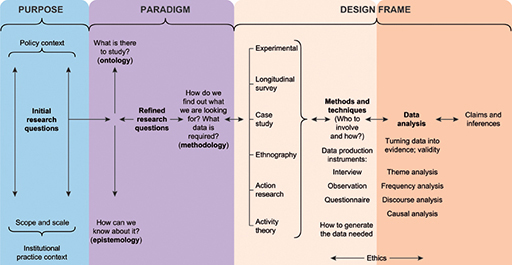4 Bringing it all together!
In Section 2.4, you were introduced to the purple, second section of the diagram below as Figure 3. You may be interested to see in Figure 10 (below) how this might fit within a wider view of the research process. There is a prior section which relates to decisions about its purpose and a following section which covers the design frames associated with the methodological position taken.
You will have come to realise that methodology and hence research design can often require the researcher to adopt different data gathering and analytic approaches, which then elicit different types of data and findings. Sometimes more than one approach is needed, and multiple method studies are common, but fundamentally it is about determining and justifying the appropriateness of the decision making needed to answer the research question(s) you wish to explore.
As a researcher you may well be asked at some point in your research career ‘what is your conceptual framework?’, which you will have referred to in the reading in Activity 7. It is useful to reflect on what this means and how it relates to the overall research process and so in this concluding section you will consider the elements that go to formulating what is known as your ‘conceptual framework’.
To help you do this, you should reflect on what has been covered so far. You have:
- explored the meanings of ontology and epistemology and how they are the theoretical roots of research paradigms;
- seen how sometimes these theoretical roots are assumed, and not discussed, in the research literature;
- examined distinct and influential ways in which people think about and study the complexities around working with children and young people and the complexities of education;
- reflected on the practices that are involved in learning and teaching childhood and youth related work and the structures that support them.
The way in which research is conceptualised and understood throughout the research process is informed by the decisions that have been taken by the researcher on the research approach itself.
The discussions shared in this course have introduced you to the concept of research paradigms and the complexities of that decision-making process. Paradigms ebb and flow over time just as debates about ‘what is research evidence?’ can challenge thinking about the purpose and value of research. It is for this reason, as a researcher, you need to be clear on what ideas, theories and concepts – for example, about learning, about childhood, about knowledge, about a world view – you have engaged with to inform your thinking about your topic and what it is you wish to investigate. These ideas make up your ‘conceptual framework’. In order to be able to articulate them you need to consider the following.
- What theorists have influenced your thinking about your topic?
- How have you chosen to position yourself in relation to relevant debates about your topic area?
- What methodology have you chosen to engage with?
- What does that methodology say about the role of the researcher?
Bringing together the choices and decisions you have made will enable you to describe and explain the conceptual framework that underpins your research. Your conceptual framework is about the process of designing and undertaking research rather than it representing an actual product. Thinking through how the theories, concepts and positions interrelate will give you a framework for communicating how you have chosen to move forward from the research process and how it has informed the development of your research.

